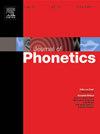Advancements in phonetics in the 21st century: Infant speech development
IF 1.9
1区 文学
0 LANGUAGE & LINGUISTICS
引用次数: 0
Abstract
Infant speech perception emerged as a field late in the 20th century. Early work focused on defining the initial state, and documenting the timecourse of changes in speech perception over the first year of life. At the turn of the century, attention shifted from studying when children became attuned to their native language, to asking how children achieved this transformation. Statistical learning became the dominant mechanism to explain language development. But, as researchers pushed the bounds of statistical learning, different questions took center stage: given the complexity of spoken language, how do infants determine which regularities to track? And are the patterns infants track influenced by their unique language learning environment? Inspired by these questions, researchers have shifted to studying acquisition across more diverse contexts, and to using dense corpora and big data approaches to examine how individual differences in children’s input relate to speech perception in the lab. In this paper, we first review this progression, summarizing how the field has arrived at the current state of the art. We then argue that the time is ripe for the development of new theoretical approaches, and sketch out the loose contours of SLED, a new 21st-century proposal that emphasizes the role of sociophonetic variation and the richness of the speech signal in early development. With advanced tools in hand and data from a wide variety of learning contexts increasingly available, we are excited to see how the field will evolve over the next 25 years.
21世纪的语音学进展:婴儿语言发展
婴儿语言感知是20世纪后期兴起的一个研究领域。早期的工作集中在定义初始状态,并记录在生命的第一年里语言感知变化的时间进程。在世纪之交,人们的注意力从研究孩子们什么时候开始适应母语转向了询问孩子们是如何实现这种转变的。统计学习成为解释语言发展的主要机制。但是,随着研究人员推动统计学习的界限,不同的问题成为了焦点:考虑到口语的复杂性,婴儿如何确定要遵循哪些规律?婴儿追踪的模式是否受到他们独特的语言学习环境的影响?受这些问题的启发,研究人员已经转向在更多样化的背景下研究习得,并在实验室中使用密集语料库和大数据方法来研究儿童输入的个体差异与语言感知的关系。在本文中,我们首先回顾了这一进展,总结了该领域如何达到当前的技术状态。然后,我们认为发展新理论方法的时机已经成熟,并勾勒出SLED的松散轮廓,这是一个21世纪的新提议,强调社会语音变异和语音信号在早期发展中的作用。有了先进的工具和越来越多的来自各种学习环境的数据,我们很高兴看到该领域在未来25年将如何发展。
本文章由计算机程序翻译,如有差异,请以英文原文为准。
求助全文
约1分钟内获得全文
求助全文
来源期刊

Journal of Phonetics
Multiple-
CiteScore
3.50
自引率
26.30%
发文量
49
期刊介绍:
The Journal of Phonetics publishes papers of an experimental or theoretical nature that deal with phonetic aspects of language and linguistic communication processes. Papers dealing with technological and/or pathological topics, or papers of an interdisciplinary nature are also suitable, provided that linguistic-phonetic principles underlie the work reported. Regular articles, review articles, and letters to the editor are published. Themed issues are also published, devoted entirely to a specific subject of interest within the field of phonetics.
 求助内容:
求助内容: 应助结果提醒方式:
应助结果提醒方式:


